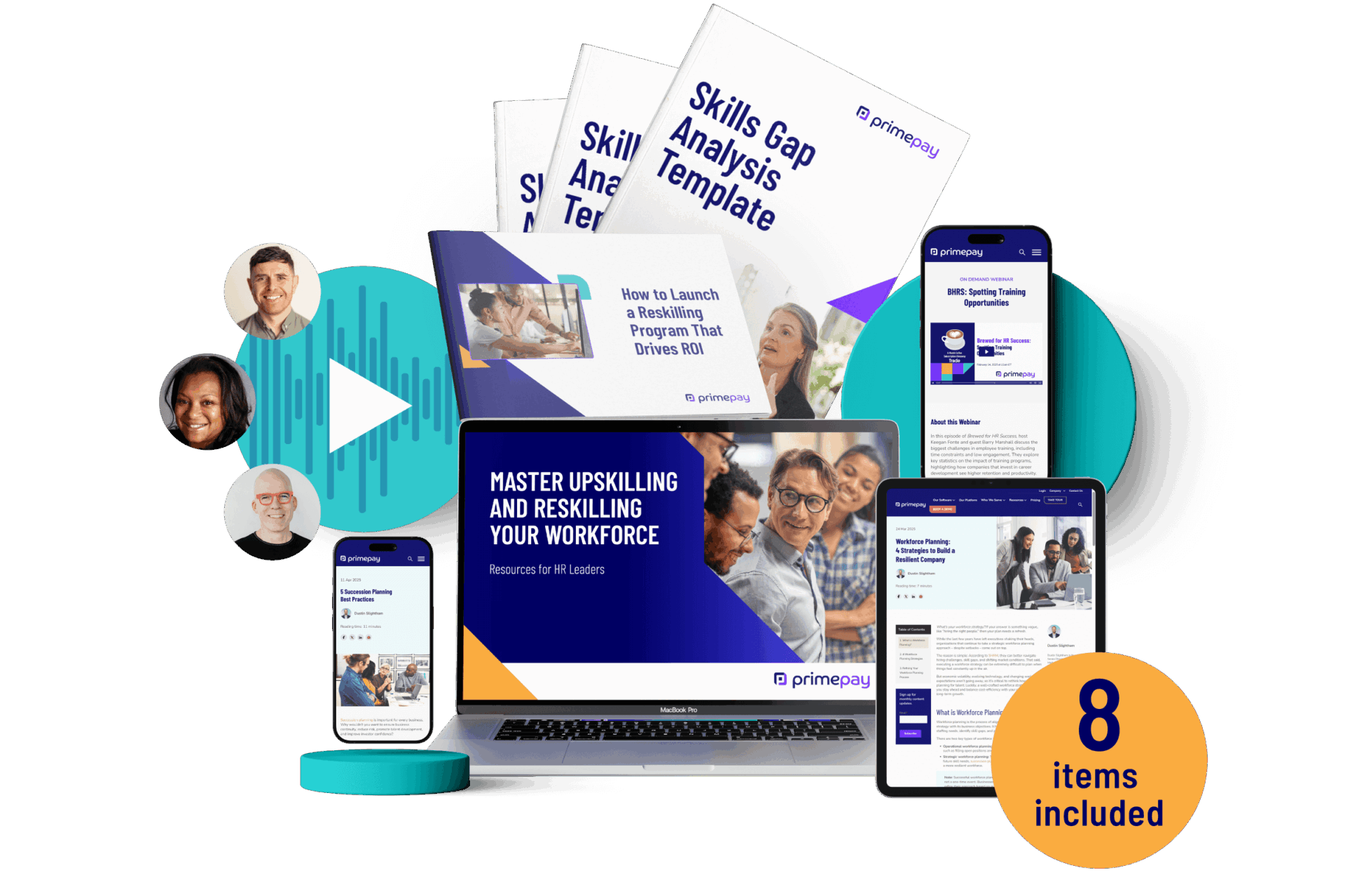The world is experiencing a skills shortage. With emerging technologies and shifting priorities, many sectors are struggling to find people with the skills needed to meet demands.
The answer is clear: Companies must focus on upskilling employees. With most Baby Boomers leaving the workforce by 2030 and the U.S. Chamber of Commerce already reporting that “there are too many jobs without people to fill them,” it’s critical that organizations utilize the people they have.
However, implementing upskilling initiatives comes with challenges. Companies must align training with fast-changing skill requirements, secure budget and leadership buy-in, and overcome any resistance to change or skepticism among managers and employees. Measuring the impact of upskilling on business outcomes can be complex, sometimes making it harder to justify investment.
Despite these hurdles, leading organizations find that the biggest risk lies in not acting – allowing skill gaps to widen and erode competitiveness.
Below are five reasons why you should prioritize reskilling your workforce and tips on how to achieve positive outcomes.
1. Close Talent Gaps and Reduce Talent Acquisition Costs
Upskilling allows companies to fill critical skill gaps from within. Rather than battling in the open market for expertise (which can be costly and time-consuming), organizations can identify high-potential employees and train them for in-demand roles and internal promotions.
The strategic payoff is twofold: the company avoids inflated salaries or recruitment fees for external hires and retains institutional knowledge by redeploying proven employees. A bonus for HR teams? You position yourself as an invaluable partner for pioneering this initiative.
Taking an upskilling approach saved telecom giant AT&T from a potential talent crisis. Facing rapid technological shifts, AT&T invested over $1 billion in a multi-year initiative to retrain nearly half its workforce, preparing them for new tech-centric roles and ensuring their skills wouldn’t become obsolete.
And over at PayPal, leaders estimated that cutting employee turnover by just 1% (through better development and retention) would save about $500,000 per year in recruiting and training costs for new hires.
Pro Tip: Even if you’re not an enterprise company like AT&T and PayPal, the above numbers strengthen the argument that investing in people is often more cost-effective than buying talent. Run your own HR metrics before pitching a reskilling initiative to prove that it’s a strategic must, not a “nice to have” program – especially since only 55% of CEOs are confident that their company can navigate filling skills gaps.
2. Increase Innovation and Competitiveness
In an economy where product cycles and business models are rapidly changing, having employees with the latest skills is a strategic asset.
When employees learn new skills—whether technical (like data science, AI, digital marketing) or soft skills (like design thinking and agile methodologies)—they bring fresh ideas and more efficient processes to the company.
We all know that new and diverse ideas are good for teams. Specifically, HBR notes that diverse teams:
- Are more focused on facts
- Make fewer errors
- Process information more carefully
- Are more innovative with processes and products
Moreover, these employees not only execute the current strategy better but also help shape future strategies by leveraging their new expertise. As a result, upskilling is now seen as vital to maintaining competitiveness because it ensures the company isn’t left behind as industries evolve.
Pro Tip: Your collective and documented knowledge should be easy for employees to find. Research shows that doing so results in a 36% increase in productivity, decision-making, and collaboration. Whether your information is housed in your project management tool, company intranet, or HCM, communicate that this location is your updated source of truth on which teams can execute.
3. Enhance Agility and Organizational Resilience
Imagine a situation where market demand shifts suddenly (as was seen in 2020 when many businesses had to go digital virtually overnight). Organizations that had been investing in digital skills were able to reassign staff to online channels, adapt workflows, and even launch new digital products in record time.
Alternatively, companies that hadn’t focused on employee upskilling scrambled to deploy critical projects, hire externally, and develop contingency plans.
Data supports this agility dividend:
- Companies that underwent reskilling report being twice as likely to feel prepared for role disruptions compared to companies that did not.
- Roughly 70% of leaders report that the business impact from reskilling programs has been greater than or equal to the investment in them.
- 48% of respondents say the programs are already enhancing bottom-line growth.
In other words, upskilling efforts give leaders confidence that when a part of the business needs to transform, the people are ready to step up.
Pro Tip: Just because your workforce has numerous skills doesn’t mean they need to do all the things. Instead, focus on capacity planning to ensure your people aren’t overly stressed by excessive workloads, tight deadlines, and insufficient planning.
4. Achieve Higher Employee Engagement and Retention
If you’re not focusing on upskilling and internal promotions, then you’re shooting your company in the figurative foot. Upskilling employees drives engagement and loyalty, which are critical and intangible assets.
Research by MIT Sloan shows that 67% of employees want to advance their careers, but 49% reported that a lack of good career advice hurt their job trajectory. Moreover, McKinsey research says that lack of career development and advancement is the most common reason people quit their jobs.
From a leadership perspective, offering continuous upskilling is a key way to energize the workforce and attract top talent. Companies known for strong development opportunities (for example, IBM or Deloitte, which both emphasize continuous learning and have formal upskilling programs) often enjoy a stronger employer brand in the talent market. Of course, employer brand is a strategic advantage in recruiting.
There’s also a link to employee morale and adaptability: Most employees report higher job satisfaction in firms with successful reskilling programs. They are motivated by the opportunity to learn, and this often translates into a willingness to take on new challenges and “go the extra mile” – a discretionary effort that is hard to generate by other means.
Pro Tip: Track your turnover by reason and tenure. Gathering this type of granular data will help you make decisions about learning and development initiatives (and overall employee experience) to improve engagement and retention.

5. Foster a Learning Culture
Perhaps the most profound strategic value of upskilling employees is creating a continuous learning culture. When a company consistently upskills its people and prioritizes internal promotions, it embeds learning into its DNA. Over time, this builds a workforce that is inherently more adaptable and future-oriented.
McKinsey found that organizations reporting successful reskilling were far more likely to have a strong culture of lifelong learning (84% of successful companies had it, versus 58% of less successful ones).
For example, the Board of Certified Safety Professionals (BCSP) is notably committed to its employee professional development – so much so that all opportunities (such as conferences, membership organizations, courses, and certifications) are paid for in full by the employer. Additionally, they offer a tuition reimbursement program for employees earning their MBAs.
Marketing Strategist Brandon Mohaupt explains that this emphasis on upskilling is a major part of BCSP’s company culture. He says: “Many of the conferences and courses I’ve attended are cost prohibitive and would not be something I could afford, and perhaps the best part of this benefit is how we are encouraged to use it. It could easily be one of those things that a company begrudgingly offers to appear like a good workplace. But we are consistently pushed to seek out professional development opportunities and grow in our roles and within the company—they want us to succeed as people first and employees second.”
Pro Tip: Promote various opportunities for learning and development. Whether it’s through mentorship programs, conferences, or an LMS, you should provide industry and role-specific training for your people to intentionally reskill.
Train Your Employees for Immediate and Long-Term Success
The biggest mistake companies make is viewing upskilling and reskilling as nice-to-have HR programs. But data shows they’re so much more than that.
Studies and programming results from companies of all sizes create the compelling case that upskilling initiatives are strategic levers that can transform an organization.
In short, organizations that lag in developing employees’ skills risk high turnover, recruitment costs, and stagnation, whereas those that invest in their people see measurable returns in performance and retention. Which camp do you want your organization to sit in?










